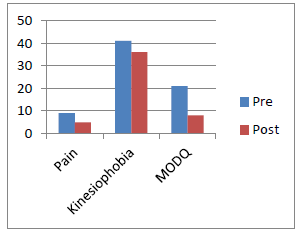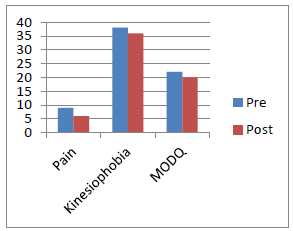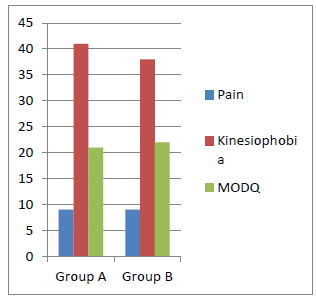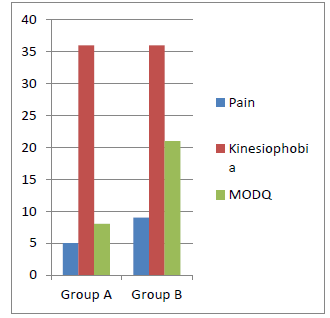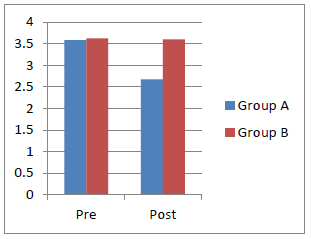Research - International Journal of Medical Research & Health Sciences ( 2023) Volume 12, Issue 6
Short-Term Effectiveness of Sand Bag Breathing Technique on Subjects with Mechanical Low Back Pain-A Randomized Controlled Trial
Radhika Chintamani*Radhika Chintamani, Assistant Professor, Faculty of Physiotherapy, College of Physiotherapy, Dayananda Sagar University, Bangalore, Karnataka, India, Email: radds2009@gmail.com
Received: 10-Jun-2023, Manuscript No. ijmrhs-23-102038; Editor assigned: 13-Jun-2023, Pre QC No. ijmrhs-23-102038(PQ); Reviewed: 19-Jun-2023, QC No. ijmrhs-23-102038(Q); Revised: 21-Jun-2023, Manuscript No. ijmrhs-23-102038(R); Published: 28-Jun-2023
Abstract
Background: Mechanical low back pain is a common cumulative musculoskeletal problem if left untreated may cause severe derangements in the spine leading to excruciating pain. The diaphragm forms a major part of the core muscle, which has a connection with obliques, rectus abdominis and transverses abdominis which further connects with latissimus dorsii and other back extensors via spiral muscle sling. Sand Bag breathing technique a type of PNF is well understood in treating respiratory disorders like asthma and COPD as it helps in the relaxation of the muscles and improves the efficiency of the respiratory muscles, thus having a positive effect on breathing. Dirth in the literature suggests that less studies have been conducted demonstrating the effects of San Bag Breathing on low back ache. Hence this study is been undertaken. Objective: To investigate the Effectiveness of Sand Bag Breathing in subjects with mechanical low back pain. Methodology: This is a randomized controlled trial conducted on mechanical low back pain 50 subjects who were divided into two groups; experimental and control. Results: Results indicated that therapy was statistically significant in the outcome measures: Pain (0.05 and 0.05), Resting Muscle thickness of Multifidus (<0.05 and 0.214), Kinesiophobia (0.05 and 0.765) and modified Oswestry disability questionnaire (0.05 and 0.212) for experimental and control group respectively. Conclusion: The Sand Bag Breathing Technique showed a significant effect in, improving the parameters related to mechanical low back pain thus suggesting it to be used as a protocol for treating subjects with back aches.
Keywords
Sandbag breathing, Mechanical low back pain, Randomised controlled trial
Introduction
Mechanical low back pain is a complex syndrome that can be defined as back pain due to mechanical causes like long-term posture maintenance and continuous repetitive movement of the spine. Studies suggest that 45% to 60% of the general population experience mechanical low back pain [1].
Delayed or no physiotherapy may lead to various mechanical derangements like the positional fault of vertebrae, facetal arthropathy, spondylolisthesis and various other dysfunctions. Trunk stabilization along with postural trunk control plays an important role in the aetiology of low back pain. One of the functions of the diaphragm is trunk stabilization, especially during postural activity. Studies have demonstrated that the pelvic girdle and lumbar spine are reflexively stabilized and braced before the initiation of lower extremity movements. This is activated by the anticipatory action of CNS thus, stabilizing the core and activating the lower extremity muscles to carry out the movement. One of the major core stabilizers is the diaphragm [2].
The Sand Bag breathing technique provides resistance to the diaphragm for breathing muscles, thus improving the breathing pattern. As the diaphragm being part of core muscles becomes weak in subjects with low back pain as already stated, the present study is carried out to demonstrate the effect of Sand Bag technique on subjects with low back pain and its parameters [3]. A fact that low back pain is associated with core stabilizer weakness, this study is been undertaken to see the effect of the Sand Bag breathing technique to strengthen the diaphragm and to check its effect on subjects with low back pain [4].
Methodology
Using data on the prevalence of mechanical low back pain, 50 participants (25 participants each in the group) were determined to be necessary [5]. Inclusion criteria for recruitment were; mechanical low back pain, subjects willing to participate in the study and age: 45 years to 55 years. Exclusion criteria were: prolapsed intervertebral disc, lumbar radiculopathy, surgery of low back or any part of the lower extremity, neoplasia, any allergic skin condition and known case of cardiopulmonary or neurological disorders. Subjects were recruited by convenience sampling with the sampling technique being random allocation by envelop method. The study population was selected from the outpatient department of physiotherapy of Dayananda Sagar University- Bangalore India, diagnosed with mechanical low back pain. This study was approved by the Institutional Ethics Committee DSU Bangalore. Subjects were informed about the study and if willing to participate and were asked to sign a written informed consent to participate in the study. Subjects were recruited based on inclusion and exclusion criteria and were divided into groups.
After recording the demographic details (age, height, weight and BMI) and outcome measures like (pain, muscle thickness of latissimus dorsii, Kinesiophobia and modified Oswestry disability questionnaire). The outcome measures were recorded pre-therapy and post-therapy.
Intervention
Pre-therapy intervention for both groups: Both groups were treated with a hot moist pack for 20 minutes [6].
• Group A: Sand Bag breathing technique along with the hot moist pack.
The subject was asked to lie supine with a thin cushion/pillow to support the head and neck, arms resting by the side of the trunk and legs neutral and apart. When the subject is relaxed in his posture and attains relaxed breathing, the Sand Bag (of 10 pounds) is placed on the abdomen just below the floating ribs. Subjects were informed to breathe normally without holding their breath for 5 minutes. The normal breathing suggests that the floating ribs just touch the Sand Bag rather than lifting it. The procedure is performed for 5 minutes, after which a rest interval is given, during which the subject is asked to breathe with a relaxed abdomen [3].
• Group B: Hot moist pack alone.
The subject is asked to go in a prone position so that the hot moist pack is placed in the lumbar region. The pack is placed for 20 minutes [6].
Duration:
• Group A: 20 minutes+5 minutes
• Group B: 20 minutes
Outcome Measures
Muscle thickness of multifidus: A 3 MHz to 7 MHz curvilinear probe of ultrasound scanner was used. The subject was asked to maintain a prone position, with a pillow under the abdomen to flatten the lumbar lordosis as this provides better contact with the transducer head, the transducer was placed longitudinally along the spine with the midpoint over the spinous process of L3. The probe was moved upwards and laterally while tilting it medially until the facet of the same level could be visualized. This predicts that the probe was directly overlying the lumbar multifidus muscle and the thickness measurement was taken from the apex of the facet joint to the plane between the thoracolumbar fascia and the subcutaneous tissue [7].
Kinesiophobia, VAS and modified oswestry disability index: Scales were administered on each subject [8-10]. The outcome measure readings were taken on pre- and post-therapy.
Consort
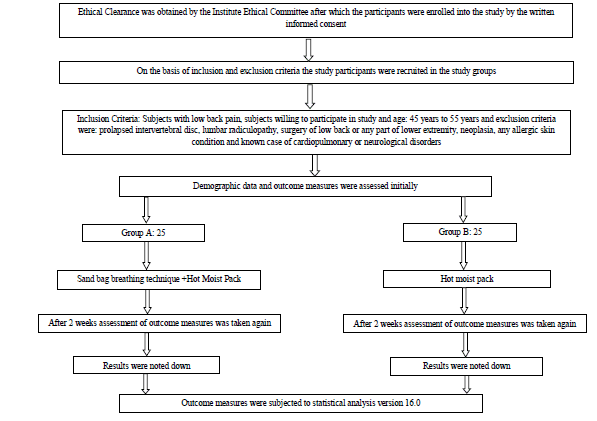
Result
Data was collected and tabulated in an Excel sheet. It was subjected to statistical analysis and the test inferred was the Wilcoxon t-test and Mann Whitney U test for within and between groups analysis respectively based on statistical version 16.0. Within group analysis for outcome measures like pain, Kinesiophobia and MODQ was analysed by Wilcoxon test and mentioned in Table 1 and Figure 1 and 2 for Group A and B respectively. Between groups analysis for outcome measures like pain, Kinesiophobia and MODQ was analysed using Mann Whitney U Test and mentioned in Table 2 and Figure 3 and 4 for Group A and B respectively. Also, muscle thickness of Multifidus for within and between group analysis by Wilcoxon test and Mann Whitney U test respectively is mentioned in Table 3 and Figure 5.
Pain, Kinesiophobia, and MODQ within-group analysis Wilcoxon test (Mean ± SD)| Activity name | Group A | Group B | ||||
|---|---|---|---|---|---|---|
| Pre | Post | p-value | Pre | Post | p-value | |
| Pain | 9 ± 2.3 | 5 ± 2.8 | 0.05* | 9 ± 3.1 | 6 ± 1.8 | 0.05* |
| Kinesiophobia | 41 | 36 | 0.05* | 38 | 36 | 0.765 |
| MODQ | 21.2 ± 1.2 | 8.1 ± 2.5 | 0.05* | 22.4 ± 6.1 | 20.1 ± 5.2 | 0.212 |
*The p-value was considered to be significant if it was <0.05 |
||||||
Pain, Kinesiophobia and MODQ between group analysis by Mann Whitney U test (Mean ± SD)
| Activity name | Pre therapy p-value | Post therapy p-value | ||||
|---|---|---|---|---|---|---|
| Pain | Kinesiophobia | MODQ | Pain | Kinesiophobia | MODQ | |
| Group A | 9 ± 2.3 | 41 | 21.2 ± 1.2 | 5 ± 2.8 | 36 | 8.1 ± 2.5 |
| Group B | 9 ± 3.1 | 38 | 22.4 ± 6.1 | 9 ± 1.8 | 36 | 20.1 ± 5.2 |
| p-value | 0.136 | 0.145 | 0.124 | 0.05* | 0.05* | 0.05* |
*The p-value was considered to be significant if it was <0.05 |
||||||
Muscle thickness of multifidus within and between group analysis by Wilcoxon test and Mann Whitney U test respectively
| Activity name | Pre therapy | Post therapy | p-value |
|---|---|---|---|
| Group A | 3.58 ± 0.46 | 2.67 ± 0.36 | 0.05* |
| Group B | 3.62 ± 0.92 | 3.60 ± 0.78 | 1.028 |
| p-value | 0.421 | 0.05* | |
*The p-value was considered to be significant if it was <0.05 |
|||
Demographic Characteristics of Participants
Age, gender, weight, and BMI were measured among groups. The details showed no significant difference between the groups.
Discussion
In the present study, all the outcome measures enlisted above were significantly improved at the end of the therapy in Group A, except that only Kinesiophobia, NDI and Facet tropism grading did not improve in Group B.
Sand Bag breathing technique in group A is known to reduce pain by stretching the multifidus. As the diaphragm muscle which was weakened before the therapy, after strengthening improves its connection with other muscles in the muscular slings it falls into. Strengthening the weakened muscle in both static and dynamic posture improves the human body, thus reducing the anterior pelvic tilt occurred due to muscle imbalance which indirectly reduces the stress over the spine thus reducing pain. Author Mehling W., demonstrated that subjects with chronic low back pain showed significant improvement with breathing therapy by strengthening the connection of transverses abdominis with the diaphragm and the back extensors. Breathing exercises along with physical therapy exercises indirectly strengthen the back extensors thus reducing chronic low back pain [11].
In group B, hot moist pack causes relaxation of the tightened muscles, which might reduce pain, but, in the present study application of a hot moist pack was not significant in reducing pain as the daily activity of the subject was not limited and the application just acted as relaxation and soothing [6].
Mechanical back pain if left untreated has various dysfunctions leading to, one such dysfunction might be lower crossed syndrome where the pelvis locks into an anterior tilt position due to muscle imbalance. As the severity increases, so does the muscle imbalance leading towards movement fear also known as Kinesiophobia. The development of Kinesiophobia is mainly due to fear of pain occurring from movement. In the present study, the Sand Bag method reduced the score on Tampa’s Kinesiophobia scale which may be due to improvement in posture as the diaphragm strengthens which leads to pulling of the muscle and alignment of the pelvis and lumbar back to normal and a decrease in severe pain. But Group B did not show any significant changes.
Along with the fear of movement and the muscle imbalance which has occurred due to untreated or neglected pain may also lead to disability in daily activity, thus having a high MODQ value. In the present study; Group A showed a definite reduction in MODQ score which may be due to decrease in pain, a reduction in Kinesiophobia and an improvement in mechanically efficient posture. But, Group B did not show any significant effect.
Few studies have demonstrated already that subacute and chronic low back pain is associated with muscle thickness. Also, many studies in the field of manual therapy have demonstrated the reduction of multifidus and erector spinae thickness occurred due to severe low back pain. In the present study, group A showed a definite reduction in muscle thickness. The reason for reduction in muscle thickness of Multifidus in group A is due to improvement in posture. As the diaphragm strengthens it attains its dome shape position which allows, the efficient muscle pull exerted by iliopsoas, rectus abdominis, erector spinae and gluteus maximus. This leads to stretch exerted on the iliopsoas and erector spinae and strengthening of rectus abdominis and gluteus maximus. This improvement in posture leads to a reduction in the thickness of the multifidus muscle. There was no significant improvement in group B in the present study.
Conclusion
Group A showed a significant difference between the groups concerning the outcome measures: Pain, Kinesiophobia, MODQ and Multifidus muscle thickness. This demonstrates that the Sand Bag breathing technique not only reduces pain, Kinesiophobia and MODQ but also indirectly reduces the Multifidus thickness as the muscle has an indirect connection with the diaphragm through transversus abdominis via a spiral muscular chain. Hence, Sand Bag breathing technique can be used to treat mechanical back pain.
Declarations
Limitation
Diaphragm muscle strength and respiration-related outcome measures were not considered in this study.
Strengths
The study considered; Pain, Kinesiophobia, MODQ and Multifidus thickness
Conflict of Interest
The authors declared no potential conflicts of interest concerning the research, authorship, and/or publication of this article.
References
- Kumar, Sanjeev, et al. "Critical analysis and MRI evaluation of patients presenting to orthopaedic department with chronic low back pain-A study of 40 cases." International Journal of Orthopaedics, Vol. 6, No. 1, 2020, pp. 134-38.
Google Scholar Crossref - Hodges, Paul W., et al. "Coexistence of stability and mobility in postural control: evidence from postural compensation for respiration." Experimental brain research, Vol. 144, 2002, pp. 293-302.
Google Scholar Crossref - Kolar, Pavel, et al. "Postural function of the diaphragm in persons with and without chronic low back pain." Journal of orthopaedic & sports physical therapy, Vol. 42, No. 4, 2012, pp. 352-62.
Google Scholar Crossref - Ganesh, B. R., et al. "Effect of Sandbag Breathing Exercise On Respiratory Parameters And Lumbar Stability In Asymptomatic Individuals-An Experimental Study." International Journal of Current Research in Medical Sciences, Vol. 4, No. 2, 2018, pp. 75-80.
Google Scholar Crossref - Latza, Ute, Annette Pfahlberg, and Olaf Gefeller. "Impact of repetitive manual materials handling and psychosocial work factors on the future prevalence of chronic low-back pain among construction workers." Scandinavian journal of work, environment & health, 2002, pp. 314-23.
Google Scholar Crossref - Sehar, Nida, et al. "Effects of moist heat therapy pre and post back extension exercises on non-specific back pain in middle aged females." International Journal of Rehabilitation Sciences, Vol. 7, 2018, p. 2-6.
Google Scholar - Skeie, Eirik Johan, et al. "Reliability of diagnostic ultrasound in measuring the multifidus muscle." Chiropractic & manual therapies, Vol. 23, 2015, pp. 1-12.
Google Scholar Crossref - Osumi, Michihiro, et al. "Correction to: Kinesiophobia modulates lumbar movements in people with chronic low back pain: a kinematic analysis of lumbar bending and returning movement." European Spine Journal, Vol. 28, No. 8, 2019, pp. 1886-86.
Google Scholar Crossref - Begum, Mst Rabea, and Mohammad Anwar Hossain. "Validity and reliability of visual analogue scale (VAS) for pain measurement." Journal of Medical Case Reports and Reviews, Vol. 2, No. 11, 2019
Google Scholar - Baradaran, Aslan, et al. "Cross-cultural adaptation, validation, and reliability testing of the modified Oswestry disability questionnaire in Persian population with low back pain." Asian spine journal, Vol. 10, No. 2, 2016, 215.
Google Scholar Crossref - Mehling, Wolf E., et al. "Randomized controlled trial of breath therapy for patients with chronic low-back pain." Alternative therapies in health and medicine, Vol. 11, No. 4, 2005, pp. 44-53.
Google Scholar

